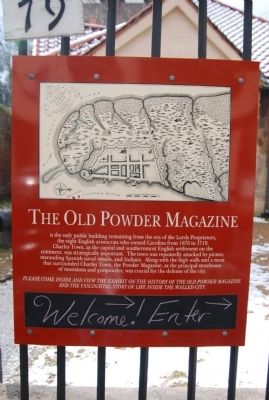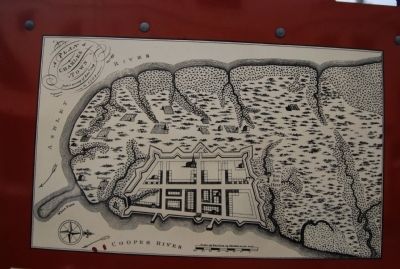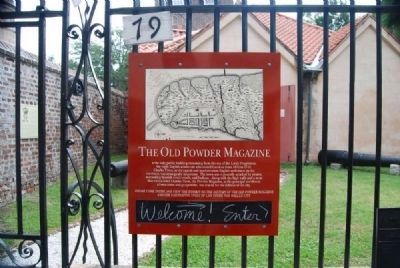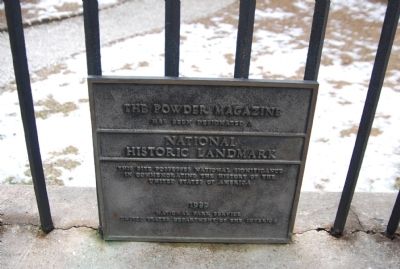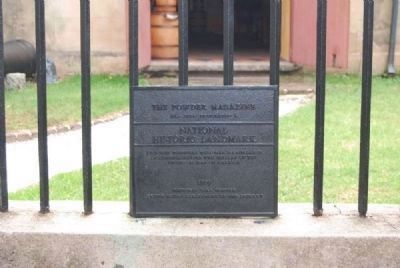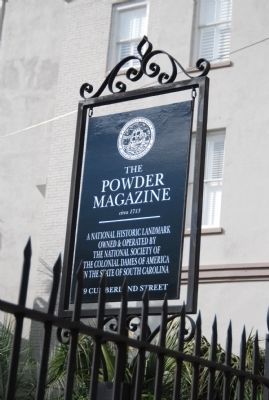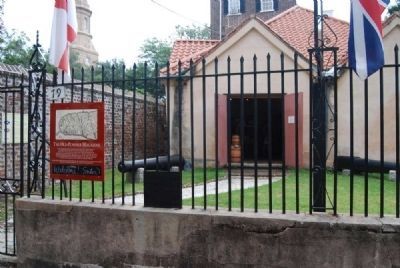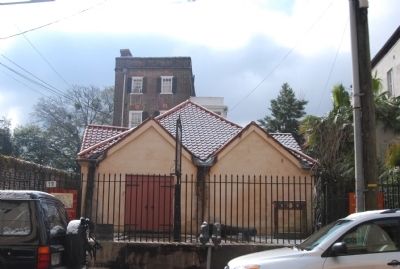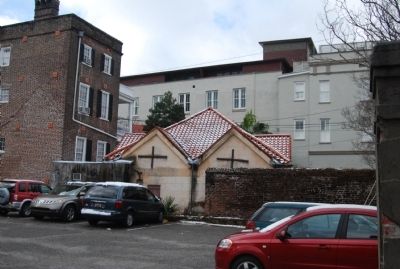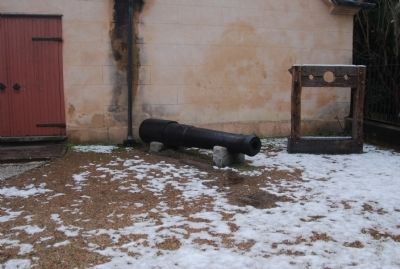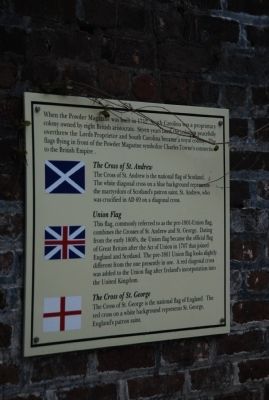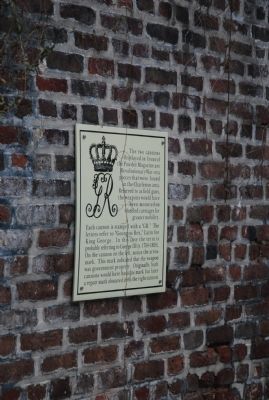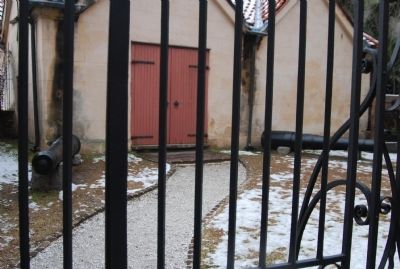French Quarter in Charleston in Charleston County, South Carolina — The American South (South Atlantic)
The Old Powder Magazine
is the only public building remaining from the era of the Lords Proprietors, the eight English aristocrats who owned Carolina from 1670 to 1719.
Charles Town, as the capital and southernmost English settlement on the continent, was strategically important. The town was repeatedly attacked by pirates, marauding Spanish naval vessels, and Indians. Along with the high walls and a moat that surrounded Charles Town, the Powder Magazine, as the principal storehouse of munitions and gunpowder, was crucial for the defense of the city.
Topics and series. This historical marker is listed in these topic lists: Colonial Era • Notable Buildings • Settlements & Settlers. In addition, it is included in the National Historic Landmarks series list. A significant historical year for this entry is 1670.
Location. 32° 46.772′ N, 79° 55.806′ W. Marker is in Charleston, South Carolina, in Charleston County. It is in the French Quarter. Marker is on Cumberland Street, 0.1 miles west of Church Street, on the left when traveling west. Touch for map. Marker is at or near this postal address: 79 Cumberland Street, Charleston SC 29401, United States of America. Touch for directions.
Other nearby markers. At least 10 other markers are within walking distance of this marker. Revolutionary Artillery (here, next to this marker); Trott's Cottage (a few steps from this marker); The Nicholas Trott House (a few steps from this marker); Powder Magazine Flags (a few steps from this marker); The Two Cannons (a few steps from this marker); Site of the First Methodist Church In Charleston (a few steps from this marker); Richard Hutson (within shouting distance of this marker); The Molony Building (within shouting distance of this marker); John Caldwell Calhoun (within shouting distance of this marker); Colonel William Rhett (within shouting distance of this marker). Touch for a list and map of all markers in Charleston.
Regarding The Old Powder Magazine. The Powder Magazine is a visible reminder of the era of the Lord Proprietors and their founding government of the Carolinas, of the fortifications which protected the city and made Charleston one of three fortified cities on the eastern seaboard of British Colonial America. It is the oldest public building in the state of South Carolina. Originally, the Powder Magazine was a brick building with a four-sided pyramidal roof intersected by two gables on each side. The roof tile is a Mediterranean type similar to that used on some of Charleston’s oldest buildings. This magazine was completed in 1713. Shortly after completion, it was found not to be sufficient to preserve the powder from rain. Repairs were made in 1717, and in 1719 the magazine was used as a storage place for public powder, as well as storage for all merchants and individuals in the city who sold powder. Further repairs were completed by 1740, when the building was stuccoed. The walls are 32 inches thick and interior walls have original brick finish. The original floor was likely packed earth or brick. The one main room is approximately 27 ft. by 27 ft. and has a central column formed by the descending arches of the vaulted ceiling. During the Revolutionary War the magazine was again used as a public magazine. Listed in the National Register January 5, 1972; Designated a National Historic Landmark September 27, 1989. (South Carolina Department of Archives and History)
Also see . . .
1. Powder Magazine. The Powder Magazine is a visible reminder of the era of the Lord Proprietors and their founding government of the Carolinas, of the fortifications which protected the city and made Charleston one of three fortified cities on the eastern seaboard of British Colonial America. (Submitted on October 7, 2011, by Brian Scott of Anderson, South Carolina.)
2. Powder Magazine. The Powder Magazine - South Carolina's Oldest Public Building. (Submitted on October 7, 2011, by Brian Scott of Anderson, South Carolina.)
3. "New" Powder Magazine 1737. Charleston's first purpose-built storehouse for gunpowder was the Old Powder Magazine, within the town's fortification wall on today's Cumberland Street. (Submitted on October 7, 2011, by Brian Scott of Anderson, South Carolina.)
4. Lords Proprietor > Carolina. There were eight Lords Proprietor of the Province of Carolina (by 1729, when seven of their descendants, all but the heir of Carteret, sold their shares to the Crown, it was split into two provinces: North and South Carolina). (Submitted on October 7, 2011, by Brian Scott of Anderson, South Carolina.)
Additional commentary.
1. Text from The Powder Magazine sign concerning the cannons
The two cannons displayed in front of the Powder Magazine are Revolutionary-era pieces that were found in the Charleston area. Referred to as field guns, the weapons would have been mounted on wheeled carriages for greater mobility.
Each cannon is stamped with a "GR." The letters refer to "Georgius Rex," Latin for King George. In this case the term is probably referring to George III (r.1760-1820). On the cannon on the left, notice the arrow mark. The mark indicated that the weapon was government property. Originally, both cannons would have had this mark but later a repair mark obscured it on the right cannon.
— Submitted February 15, 2010, by Michael Sean Nix of Spartanburg, South Carolina.
2. The Lords Proprietors
— Submitted October 7, 2011, by Brian Scott of Anderson, South Carolina.
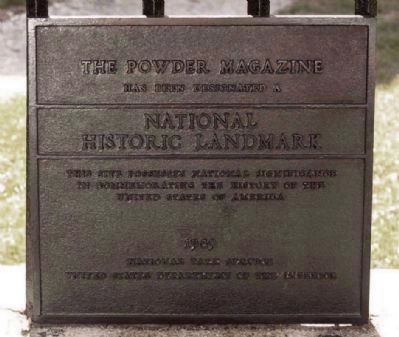
Photographed By Mike Stroud, October 6, 2011
5. The Powder Magazine National Register of Historic Landmark 1989
National Register of Historic Places:
Powder Magazine *** (added 1972 - - #72001200)
♦ Historic Significance: Architecture/Engineering, Event
♦ Area of Significance: Architecture, Military
♦ Period of Significance: 1700-1749
♦ Historic Function: Defense
(Listed in the National Register January 5, 1972; Designated a National Historic Landmark September 27, 1989)
♦ Historic Significance: Architecture/Engineering, Event
♦ Area of Significance: Architecture, Military
♦ Period of Significance: 1700-1749
♦ Historic Function: Defense
(Listed in the National Register January 5, 1972; Designated a National Historic Landmark September 27, 1989)
Credits. This page was last revised on February 16, 2023. It was originally submitted on February 15, 2010, by Michael Sean Nix of Spartanburg, South Carolina. This page has been viewed 1,089 times since then and 37 times this year. Photos: 1, 2. submitted on February 15, 2010, by Michael Sean Nix of Spartanburg, South Carolina. 3. submitted on October 7, 2011, by Brian Scott of Anderson, South Carolina. 4. submitted on February 15, 2010, by Michael Sean Nix of Spartanburg, South Carolina. 5. submitted on October 6, 2011, by Mike Stroud of Bluffton, South Carolina. 6. submitted on October 7, 2011, by Brian Scott of Anderson, South Carolina. 7. submitted on February 15, 2010, by Michael Sean Nix of Spartanburg, South Carolina. 8. submitted on October 7, 2011, by Brian Scott of Anderson, South Carolina. 9, 10, 11, 12, 13, 14. submitted on February 15, 2010, by Michael Sean Nix of Spartanburg, South Carolina. • Bill Pfingsten was the editor who published this page.
